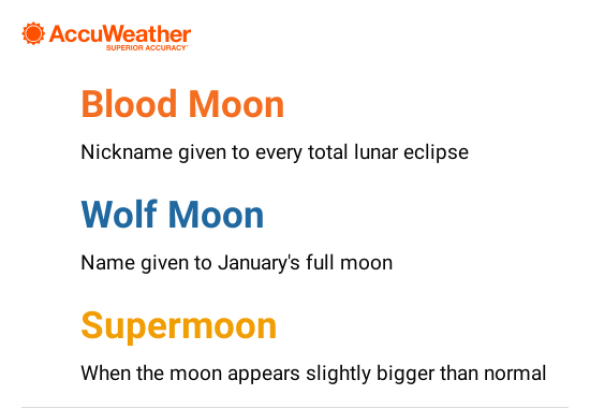Photos of Sunday night's lunar eclipse from all around the world
A total lunar eclipse glowed red in the night sky on Sunday night, the last of its kind anywhere in the world until 2021.
People across North America, South America, western Europe and western Africa were able to see the moon change color as it passed directly through Earth's shadow.
Those in the northeastern United States braved temperatures in the single digits and teens with winds pushing AccuWeather RealFeel® Temperatures below zero F to see the spectacle. The sky cleared just in time for most of the region to view the eclipse in the wake of a snowstorm.
Some lunar eclipse viewing parties were canceled in the central and eastern U.S. due to icy roadways and bitterly cold conditions, according to Reuters.
Stunning images capture the total lunar eclipse
AP Photo/Garret Fischer



First, at vero eos et accusamus et iusto odio dignissimos ducimus qui blanditiis praesentium et accusamus et iusto odio dignissimos ducimus qui voluptatum.
















Twitter/@Astrodunk
The lunar eclipse in France on Sunday night, Jan. 20, 2019.

Twitter/@RichTPar
The lunar eclipse over Los Angeles on Sunday night, Jan. 20, 2019.

AP Photo/Ringo H.W. Chiu
People watch the lunar eclipse at the Griffith Observatory in Los Angeles, Sunday Jan. 20, 2019.

Twitter/@arihalbkram

Twitter/@nat_sibaja
The lunar eclipse over Costa Rica on Sunday night, Jan. 20, 2019.

AP Photo/J. David Ake
A U.S. Flag in downtown Washington flies in front of the moon during a lunar eclipse, Sunday, Jan. 20, 2019.

Twitter/@caseybaldin
The lunar eclipse over Chicago on Sunday night, Jan. 20, 2019.

AP Photo/Eraldo Peres
A lunar eclipse progresses behind the "Memorial JK," a monument in honor of the founder of Brasilia, Brazil, Monday, Jan. 21, 2019.

Twitter/@AndrewC75
The lunar eclipse over Cherokee County, Georgia, on Sunday night, Jan. 20, 2019.

Twitter/@wmhammond
The lunar eclipse over Oklahoma on Sunday night, Jan. 20, 2019.

Twitter/@Chesapecten
The lunar eclipse over Virginia on Sunday night, Jan. 20, 2019.

Twitter/@SJDJ
The lunar eclipse over British Columbia, Canada, on Sunday night, Jan. 20, 2019.

AP Photo/Ringo H.W. Chiu
This combination photo shows the totally eclipsed moon, center, and others at the different stages during a total lunar eclipse, as seen from Los Angeles, Sunday, Jan. 20, 2019.

Twitter/@wxlada
The lunar eclipse over central Pennsylvania on Sunday night, Jan. 20, 2019.

AP Photo/Leo Correa
A blood moon rises above Christ the Redeemer statue during a lunar eclipse in Rio de Janeiro, Brazil, Monday, Jan. 21, 2019.

Clouds broke just in time for the eclipse to be seen in Los Angeles, but rain spoiled the show in San Francisco, while clouds hung over San Diego.
Pictures on social media showed clear viewing conditions across portions of Costa Rica, Brazil, Italy, France and British Columbia, Canada, among many other areas.
This particular eclipse was given the unofficial nickname of the 'Super Blood Wolf Moon,' despite looking like any other total lunar eclipse. This long-winded name derived from three nicknames being combined into one.

The next time that a total lunar eclipse will be visible anywhere in the world will not be until May 26, 2021. However, there will be five partial lunar eclipses before then.
RELATED:
Blood moons explained: Why the moon turns red during lunar eclipses
Follow AccuWeather Astronomy on Twitter
3 tips for stargazing without a telescope
#LunarEclipse #LosAngeles #LA #DTLA #abc7eyewitness pic.twitter.com/CdZcoloA4I
— Michael (@RealDoubleMs) January 21, 2019
Seattle, look to the sky! #LunarEclipse #lunareclipse2019 pic.twitter.com/Td1aUG7Zg1
— Lindsay Cohen (@lindsaycohen) January 21, 2019
Lunar eclipse! Beautiful shades of pink and red here in #Houston. It looks like the moon is on fire. #LunarEclipse2019 pic.twitter.com/22QIhtDEpQ
— Terry Virts (@AstroTerry) January 21, 2019
Super blood wolf moon. @NASA @accuweather @breakingweather @NASAMoon @GenePark @Space_Station @SpaceX personal pic from #seattle #wa pic.twitter.com/1VL416XH9A
— WX-EatonvilleWA (@EatonvilleWAWX) January 21, 2019
1 minute to totality, peak ~5.10am #lunareclipse pic.twitter.com/fs5AnuDaUu
— Lancaster University Astronomy Society (@LancasterAstro) January 21, 2019
#BloodMoonEclipse Philly City Hall pic.twitter.com/HOT3Ww1H8C
— PhillyChitChat (@HughE_Dillon) January 21, 2019


